|
TennisOne Lessons
Senior Tennis: Strategies to Enhance ‘Seasoned' Players! Old dogs can learn new tricks! A Series on Senior Player Improvement:
|
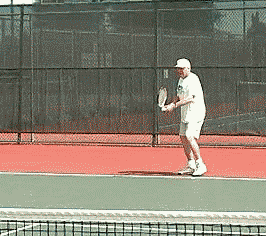 Senior players can learn to hit skilled strokes just like anyone else. The issue is whether or not they are willing to try! |
These players I speak of would be classified as “senior” players.
The issue of senior improvement is both diverse and unique. Most senior players have the distinction of having played for a long time. (Although, I have trained 60 and 70-year-old “beginners” - many of which took to learning with similar vigor, if not more, than some of the youngsters I have taught!) This longevity of participation creates both physical and mental distinctiveness in terms of learning new techniques or simply working on improving existing strokes and strategies.
These unique characteristics make writing a single, comprehensive article addressing all the issues of senior tennis nearly impossible. Thus, I will address senior tennis in a series of four articles:
- An Overview
- Playing Strategies
- Shot-making Strategies
- Do's and Don'ts
Senior “Mentality”
I have been fortunate to have worked with a broad spectrum of tennis players; from little kids to nationally and world-ranked juniors, from every level of adult to senior players of every age, sex, and ability. I currently work with dozens of players over the age of 60, one of which is ranked in the top 10, Jerry Golding, a former #1 nationally ranked 70 year old now in her early 80's. Many others I teach are medalists in national senior events. And while there are many aspects to learning and improving our tennis skills that cross every gender and generational line, there are many aspects of tennis that are specifically related to the senior population.
Because age has various effects on people, (from the obvious physical changes to the more subtle and less predictable psychological changes), there are many avenues the senior player—and the pros who teach senior players—should explore.
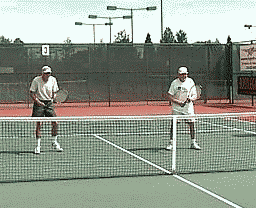 While many senior players have limited mobility, the majority of shots are within reach of most players to make a play on the ball. |
One of the most rewarding teaching opportunities I have had is when I see my senior students begin to recognize, (like most of my junior players), that improvement is not just an option, but a reality! Seeing these older players set new goals, look for new ways to accomplish specific strokes, understand and execute new strategies, and simply look at playing tennis in a new light, gives me a sincere thrill!
Yet, the senior player can also be one of the most frustrating students. Many insist (erroneously!) they are too old to learn new tennis techniques. This mentality is far more limiting than almost any physical handicap! When senior players let go of this detrimental mindset, they then open doors that can lead to many fulfilling and exciting opportunities in tennis.
Another problem senior players have is the stubbornness that comes from playing a long time. Some players refuse to explore or acknowledge that there may be better ways to play the game! Others actually think they are doing one thing when in reality they are doing something quite different. I remember a senior player who was hitting a severe slice yet insisted she was hitting topspin!
Improvement: Change or Maintain?
If a senior player of any age has been playing tennis for a long time, they must make a conscious decision: Do I want to remain at my current level? Or, Do I want to see if I can reach higher levels of play? If current strokes and techniques are limiting in terms of playing higher levels of tennis, then obviously the player must look at changing such limiting strokes if indeed they wish to improve. However, many senior players have adequate strokes to compete with most players, (senior or otherwise), and need not change their strokes or technique, but rather the strategies they are employing. Such changes might include coming to the net more, getting out of no-man's land, lobbing, hitting drop shots, using angle volleys, and a host of other strategies that can improve their chances of not just competing with better players, but beating them as well! In my next article, I will discuss some terrific strategies that senior players might want to explore!
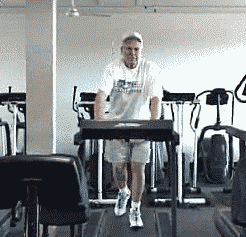 A subtle work out can go a long way! Senior players should consider improving their conditioning, strength, and flexibility in an off-court training program. |
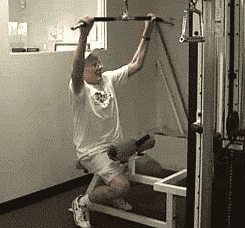 |
Physical Conditioning
Senior players are notorious for not conditioning or improving their physical selves. Obviously, pain from typical senior ailments including arthritis, stiffness, joint disorders, and the like, will deter a player from wanting to work their body as much as people who don't experience such discomforts. However, done within qualified recommendations, senior players can help decrease some pain while improving stamina and flexibility through a sensible exercise program. Simple exercises such as walking, lifting light weights, stretching and cardio-vascular workouts can make a world of difference in both the quality of play and the enjoyment senior players' gain through such efforts.
However, it is amazing to watch my senior players who allow themselves to be pushed and end up actually surprising themselves at what they can do. Working in incremental steps and using common sense when working at more demanding exercises can improve most players. Depending on age and physical condition, it is recommended that most senior players consult a physician in determining what is appropriate within this area of exercise and physical exertion.
New Opponents
One area that senior players get caught up in is playing the same opponents week after week. While the security and social enjoyment of playing “comfortable” opponents is usually fun and fulfilling, in terms of learning more about the game as well as learning how to adjust strategies, players usually find themselves hitting the same shots over and over against familiar opponents.
At my Academy, we run what we call “Super Saturday” where we host a short, 3-hour tournament in a ‘fast format' style of play. We attract nearly 50 players each Saturday and of these, about a third are seniors, a third are younger adults, and a third junior players. It is very rewarding to see such diversity both in age and sex among our local players and visitors. The senior players often find a new excitement in playing with and against younger players. Not only do they see themselves improving, but they sometimes have a vested interest in seeing the younger players improve. In fact, it is common to have a seventy or even an eighty-year-old paired with a good 10 or 12 year old! (What other active sport can say that!)
Senior Strategies
When performance qualities such as speed, quickness, and reactions diminish due to the natural aging process, senior players usually look to employ different strategies to accommodate such deficiencies. However, many senior players don't explore strategies that would not only help them compete, but also help them beat other players, young or old. It is common to watch senior players hit the same shot over and over throughout a match.
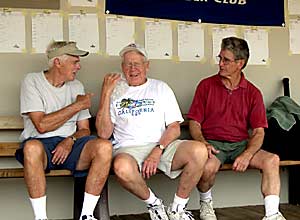 While pain and injuries are more common for senior players, reasonable training and discipline can go a long way to making sure that tennis is a “lifetime” sport for all! |
Training both in creating diverse shots as well as practicing their execution in competition is a valuable training exercise that can greatly increase the competitiveness of senior players. In my next article, I will address many of these strategies that can be beneficial to all senior players.
Conclusion
Senior players take note: You can improve! From learning new techniques to new strategies, from improving your health and, consequently, your ability to compete, you can become a much better player!
Keep an open mind and a positive outlook! And, keep your good eye pealed for the next article in this series!
Your comments are welcome. Let us know what you think about Dave Smith's article by emailing us here at TennisOne .
![]()
 TENNIS MASTERY
TENNIS MASTERY
Finally… a resource that unlocks these mysteries:
• Why do millions of tennis players stagnate at levels far below their potential?
• Why are making changes in one's game so frustratingly difficult?
• What tennis teaching methods are disruptive or detrimental to player progression?
Read David W. Smith's TENNIS MASTERY and learn not just how to avoid playing at mediocre levels, but how the best players in the world Master the sport of tennis!
“With a depth of knowledge and fresh perspective, TENNIS MASTERY is set to become a manual for tennis instructors and a measure for tennis literature.” Richard Wigley, Director, Kayenta Tennis Center , Ivins Utah .
Take in David Smith's 30 plus years in the tennis teaching industry. This 335-page manual will provide for every level of player as well as support for all tennis-teaching professionals, a blueprint for reaching higher levels of tennis mastery.
Order TENNIS MASTERY at tenniswarehouse.com , or go to tennismastery.net for exciting excerpts from the book and a host of tennis information!
And check out David Smith's other articles found here at TennisONE.com
 Your comments are welcome. Let us know what you think about this article by emailing us here at TennisONE.
Your comments are welcome. Let us know what you think about this article by emailing us here at TennisONE.
David W. Smith is the Director of Tennis for the St. George Tennis Academy in St. George Utah. He has been a featured writer in USPTA's magazine ADDvantage in addition to having over 50 published articles in various publications.
David has taught over 3000 players including many top national and world ranked players. He can be reached at acrpres1@email.msn.com.
